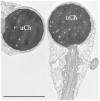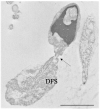The relevance of sperm morphology in male infertility
- PMID: 36303645
- PMCID: PMC9580829
- DOI: 10.3389/frph.2022.945351
The relevance of sperm morphology in male infertility
Abstract
This brief report concerns the role of human sperm morphology assessment in different fields of male infertility: basic research, genetics, assisted reproduction technologies, oxidative stress. One of the best methods in studying sperm morphology is transmission electron microscopy (TEM) that enables defining the concept of sperm pathology and classifying alterations in non-systematic and systematic. Non-systematic sperm defects affect head and tail in variable ratio, whereas the rare systematic defects are characterized by a particular anomaly that marks most sperm of an ejaculate. TEM analysis and fluorescence in situ hybridization represent outstanding methods in the study of sperm morphology and cytogenetic in patients with altered karyotype characterizing their semen quality before intracytoplasmic sperm injection. In recent years, the genetic investigations on systematic sperm defects, made extraordinary progress identifying candidate genes whose mutations induce morphological sperm anomalies. The question if sperm morphology has an impact on assisted fertilization outcome is debated. Nowadays, oxidative stress represents one of the most important causes of altered sperm morphology and function and can be analyzed from two points of view: 1) spermatozoa with cytoplasmic residue produce reactive oxygen species, 2) the pathologies with inflammatory/oxidative stress background cause morphological alterations. Finally, sperm morphology is also considered an important endpoint in in vitro experiments where toxic substances, drugs, antioxidants are tested. We think that the field of sperm morphology is far from being exhausted and needs other research. This parameter can be still considered a valuable indicator of sperm dysfunction both in basic and clinical research.
Keywords: assisted reproduction technologies (ART); genetics; human sperm; oxidative stress; sperm morphology; systematic sperm defects; transmission electron microscopy.
Copyright © 2022 Moretti, Signorini, Noto, Corsaro and Collodel.
Conflict of interest statement
The authors declare that the research was conducted in the absence of any commercial or financial relationships that could be construed as a potential conflict of interest.
Figures




Similar articles
-
The importance of transmission electron microscopy analysis of spermatozoa: Diagnostic applications and basic research.Syst Biol Reprod Med. 2016 Jun;62(3):171-83. doi: 10.3109/19396368.2016.1155242. Epub 2016 Mar 16. Syst Biol Reprod Med. 2016. PMID: 26980361 Review.
-
An illustration of human sperm morphology and their functional ability among different group of subfertile males.Andrology. 2018 Sep;6(5):680-689. doi: 10.1111/andr.12500. Epub 2018 Jun 29. Andrology. 2018. PMID: 29959832
-
Genetic diagnosis, sperm phenotype and ICSI outcome in case of severe asthenozoospermia with multiple morphological abnormalities of the flagellum.Hum Reprod. 2021 Oct 18;36(11):2848-2860. doi: 10.1093/humrep/deab200. Hum Reprod. 2021. PMID: 34529793
-
Another look at human sperm morphology.Hum Reprod. 2016 Jan;31(1):10-23. doi: 10.1093/humrep/dev251. Epub 2015 Oct 14. Hum Reprod. 2016. PMID: 26472152
-
Sperm DNA damage caused by oxidative stress: modifiable clinical, lifestyle and nutritional factors in male infertility.Reprod Biomed Online. 2014 Jun;28(6):684-703. doi: 10.1016/j.rbmo.2014.02.004. Epub 2014 Mar 4. Reprod Biomed Online. 2014. PMID: 24745838 Review.
Cited by
-
Scriptaid is a prospective agent for improving human asthenozoospermic sample quality and fertilization rate in vitro.Asian J Androl. 2024 Sep 1;26(5):490-499. doi: 10.4103/aja202416. Epub 2024 Jun 11. Asian J Androl. 2024. PMID: 38856299 Free PMC article.
-
Impact of Shorter Abstinence Periods on Semen Parameters: A Systematic Review and Meta-Analysis.World J Mens Health. 2025 Jul;43(3):563-579. doi: 10.5534/wjmh.240035. Epub 2024 Sep 27. World J Mens Health. 2025. PMID: 39434390 Free PMC article.
-
L-Carnitine and Acetyl-L-Carnitine: A Novel Approach to Treating Male Infertility with Abnormal Sperm Morphology.J Pharm Bioallied Sci. 2025 May;17(Suppl 1):S1038-S1041. doi: 10.4103/jpbs.jpbs_256_25. Epub 2025 Apr 12. J Pharm Bioallied Sci. 2025. PMID: 40511105 Free PMC article.
-
Exploring the impact of lipid stress on sperm cytoskeleton: insights and prospects.Nat Rev Urol. 2025 May;22(5):294-312. doi: 10.1038/s41585-024-00952-1. Epub 2024 Nov 11. Nat Rev Urol. 2025. PMID: 39528754 Review.
-
Artificial Intelligence for Clinical Management of Male Infertility, a Scoping Review.Curr Urol Rep. 2024 Nov 9;26(1):17. doi: 10.1007/s11934-024-01239-z. Curr Urol Rep. 2024. PMID: 39520645 Free PMC article.
References
-
- World Health Organization (WHO) . WHO Manual for the Laboratory Examination and Processing of Human Semen. 6th ed. WHO press: Geneva Switzerland; (2021).
-
- Agarwal A, Sharma R, Gupta S, Finelli R, Parekh N, Panner Selvam MK, et al. . Sperm morphology assessment in the era of intracytoplasmic sperm injection: reliable results require focus on standardization, quality control, and training. World J Mens Health. (2021) 40:347–60. 10.5534/wjmh.210054 - DOI - PMC - PubMed
-
- World Health Organization (WHO) . WHO Laboratory Manual for the Examination of Human Semen and Sperm-Cervical Mucus Interaction. 4th ed. Cambridge: Cambridge University Press; (1999).
LinkOut - more resources
Full Text Sources

